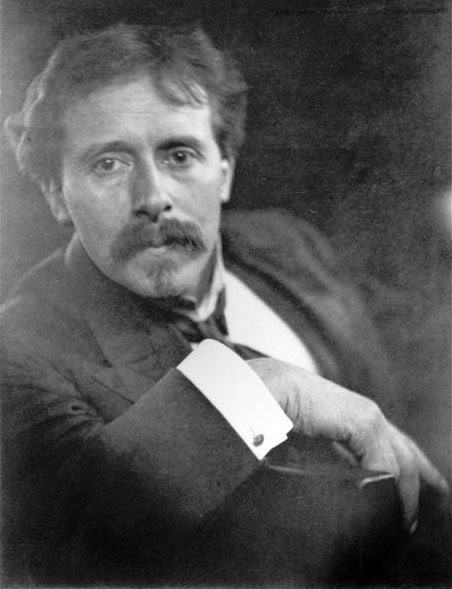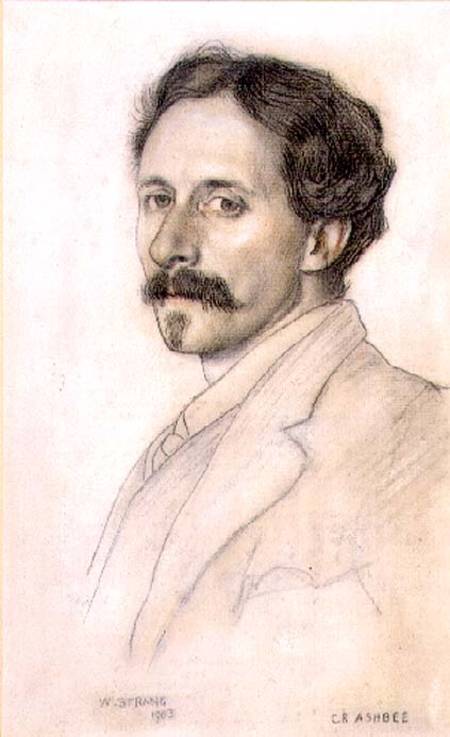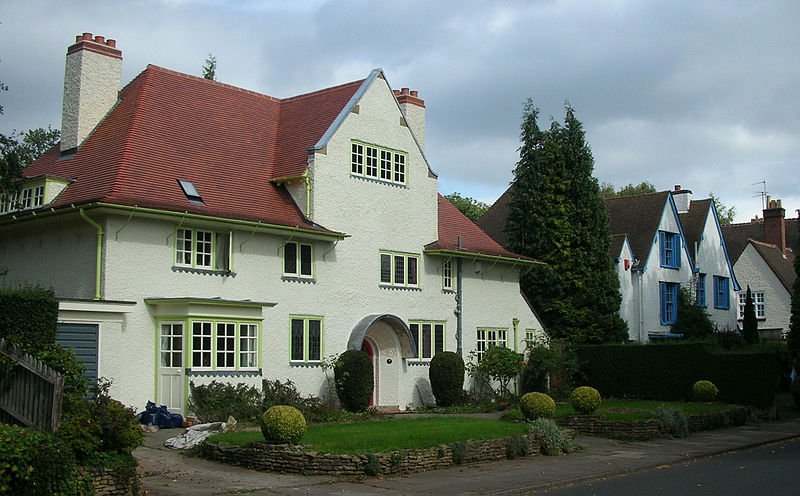<Back to Index>
- Architect Philip Speakman Webb, 1831
- Designer Charles Robert Ashbee, 1863
- Architect Herbert Tudor Buckland, 1869
PAGE SPONSOR

Philip Speakman Webb (12 January 1831 – 17 April 1915) was an English architect — sometimes called the 'Father of Arts and Crafts Architecture'.
Born in Oxford, Webb studied at Aynho in Northamptonshire and was then articled to firms of builder - architects in Wolverhampton and Reading, Berkshire. He then moved to London where he eventually became a junior assistant for G.E. Street. While there he met William Morris in 1856 and then started his own practice in 1858.
He is particularly noted as the designer of Red House at Bexleyheath, southeast London in 1859 for William Morris, and — towards the end of his career — the house Standen (near East Grinstead in West Sussex). These were among several works in his favored niche: country houses.
William Morris, Edward Burne - Jones and Dante Gabriel Rossetti were three of his fellow partners in the interior decorating and furnishing business, Morris, Marshall, Faulkner & Co., later to become Morris & Co.
Webb and Morris formed an important part of the Arts and Crafts movement, and founded the Society for the Protection of Ancient Buildings in 1877. Webb also joined Morris's revolutionary Socialist League, becoming its treasurer.
George Howard of Naworth Castle near Brampton in Cumbria was an able artist and friend of the Pre - Raphaelites, and a keen patron of Philip Webb. Webb had built two houses for his Naworth Castle Estate: Four Gables and Green Lane House, as well as his London house at 1, Palace Green. Much financial help was offered towards building a new church in Brampton by Charles Howard MP (George Howard's father) on condition that he chose the architect.
Webb's plan for St Martin's Church is quite unlike most other Victorian churches, with the body of the church being almost square. It is the only church designed by Webb, and contains an exquisite set of stained glass windows designed by Burne - Jones, and executed in the William Morris studio.
His friendship with the family of Sir Thomas Hugh Bell, leading iron founder of Middlesbrough, led to three commissions - of Rounton Grange (demolished in 1953), Red Barns House and the Dorman Long office building (originally Bell Brothers Ltd) in Middlesbrough (his only commercial development).
In 1901 Philip Webb retired to the country and ceased practicing. He continued to be an influence on the "school of rational builders" surrounding William Lethaby, and Ernest Gimson and his community of architect - craftsmen based at Sapperton in Gloucestershire.


Charles Robert Ashbee (Isleworth, 17 May 1863 – Sevenoaks, Kent, 23 May 1942) was an English designer and entrepreneur who was a prime mover of the Arts and Crafts movement that took its craft ethic from the works of John Ruskin and its co-operative structure from the socialism of William Morris.
He was the son of businessman and erotic bibliophile Henry Spencer Ashbee. His Jewish mother developed suffragette views, and his well educated sisters were progressive as well. Ashbee went to Wellington College and read history at King's College, Cambridge, from 1883 to 1886, and studied under the architect George Frederick Bodley.
Ashbee set up his Guild and School of Handicraft in 1888 in London, while a resident at Toynbee Hall, one of the original settlements set up to alleviate inner city poverty, in this case, in the slums of Whitechapel. The fledgling venture was first housed in temporary space but by 1890 had workshops at Essex House, Mile End Road, in the East End, with a retail outlet in the heart of the West End in fashionable Brook Street, Mayfair, more accessible to the Guild's patrons. In 1902 the works moved to Chipping Campden, in the picturesque Cotswolds of Gloucestershire, where a sympathetic community provided local patrons, but where the market for craftsman designed furniture and metalwork was saturated by 1905. The London County Council's introduction of the polytechnic institutes, which took on craft workers at a minimal charge, was inspired by Ashbee's Guild and School, which it out - competed and drove out of business. The Guild was liquidated in 1907. One of Ashbee's pupils in Mile End was Frank Baines, later Sir Frank, who was enormously influential in keeping Arts and Crafts alive in 20th century architecture.
The Guild of Handicraft specialized in metalworking, producing jewellery and enamels as well as hand wrought copper and wrought ironwork, and furniture. (A widely illustrated suite of furniture was made by the Guild to designs of M.H. Baillie Scott for Ernest Louis, Grand Duke of Hesse at Darmstadt). The School attached to the Guild taught crafts.The Guild operated as a co-operative, and its stated aim was to:
- "seek not only to set a higher standard of craftsmanship, but at the same time, and in so doing, to protect the status of the craftsman. To this end it endeavors to steer a mean between the independence of the artist— which is individualistic and often parasitical — and the trade shop, where the workman is bound to purely commercial and antiquated traditions, and has, as a rule, neither stake in the business nor any interest beyond his weekly wage".
Ashbee himself was willing to do complete house design, including interior furniture and decoration, as well as items such as fireplaces. In the 1890s he renovated The Wodehouse near Wombourne for Colonel Shaw - Hellier, commandant of the Royal Military School of Music, adding a billiard room and chapel, amid many external changes. Shaw-Hellier commissioned him in 1907 to build the Villa San Giorgio in Taormina, Sicily as a little island of England in Italy, hence the name of the patron saint. MacCarthy judges it "the most impressive of Ashbee's remaining buildings"; it is run as the Hotel Ashbee.
Ashbee was involved in book production and literary work. He set up the Essex House Press after Morris's Kelmscott Press closed in 1897, taking on many of the displaced printers and craftsmen. Between 1898 and 1910 the Essex House Press produced more than 70 titles. Ashbee designed two type faces for the Essex House Press, Endevour (1901) and Prayer Book (1903), both of which are based on Morris' Golden Type.
Ashbee wrote two utopian novels influenced by Morris, From Whitechapel to Camelot (1892) and The Building of Thelema (1910), the latter named after the abbey in François Rabelais' book Gargantua and Pantagruel. Ashbee also founded the Survey of London.
In 1918 he was appointed civic adviser to the British Mandate of Palestine, overseeing building works and the protection of historic sites and monuments as the chairman of the Pro - Jerusalem Society. He summoned his family to Jerusalem, where they lived until 1923.
His papers and journals are at King's College.
Despite his father's amateur career as an enthusiastically heterosexual pornographer, Ashbee was gay. He came of age in a time when homosexuality was illegal and "the love that dare not speak its name". He is thought to have been a member of the Order of Chaeronea, a secret society founded in 1897 by George Ives for the cultivation of a homosexual ethos. To cover his homosexuality, he married Janet Forbes, daughter of a wealthy London stockbroker. CRA, as he was known, had admitted his sexual orientation to his future wife shortly after he proposed. They wed in 1898 and, after 13 years of rocky marriage (including a serious affair on the part of Janet), had children: Mary, Helen, Prue and Felicity.
Herbert Tudor Buckland (November 20, 1869 – 1951) was a British architect, best known for his seminal Arts and Crafts houses (several of which, including his own at Edgbaston, Birmingham, are Grade I listed), the Elan Valley model village, educational buildings such as the campus of the Royal Hospital School in Suffolk and St Hugh's College in Oxford.
Buckland was born in Barmouth, Wales and educated at King Edward's School, Birmingham and the school of architecture at Birmingham School of Art. After a period working for C.E. Bateman at the firm Bateman and Bateman Buckland set up in independent practice in 1897, entering into partnership with Edward Haywood - Farmer in 1900. In 1914, he went into partnership with William Haywood, Edward Haywood - Farmer's relative and on Haywood - Farmer's death in 1917 the practice continued with William Haywood as Buckland and Haywood.
Buckland followed William Martin as architect to the School Board in 1901 and then served as architect to the City of Birmingham Education Committee after the abolition of school boards in 1902: his buildings are among Birmingham's most forward looking of their time. He also sat on the Executive Council of The Birmingham Civic Society which devised many schemes for the improvement of Birmingham in the 1920s and 1930s including the purchase of many parks and open spaces which were gifted to the city. Much of modern Birmingham owes its origins to the ideas put forward by Buckland and Haywood over 75 years ago.
The partnership of Buckland - Farmer operated from offices in Norwich Union Chambers, Corngreve Street (now demolished). Buckland & Haywood specialized in school work, and St Hugh’s College, Oxford (1914 – 16) gained them a national reputation. Their largest work in this field is the Royal Hospital School, Holbrook, Suffolk (1925 – 33), which includes a splendid chapel.
In his domestic work Buckland showed an originality that was much admired, helping make Birmingham the center for a magnificent group of provincial architects (a rare thing in Britain, where the Capital is one of the most metropolitan) at a time when London architects were some of the world's best. Alan Crawford, distinguished authority on the Arts and Crafts period, confirms that Buckland "developed such a highly personal style of such quality in domestic work that he must rank with the best of his time" - Edwin Lutyens, Charles Voysey and Baillie Scott. Buckland's designs were much copied by his contemporaries and comparisons with Voysey are interesting.

